Lightning - the phenomenon in our latitudes is quite frequent. Often it falls into unprotected buildings and large trees, which is why lightning protection is an important aspect to preserve the integrity of structures and even human life. Such a fuse from the elements can be made independently.
Content
- Lightning protection of buildings and structures: what is it?
- Lightning protection of buildings: technology nuances
- Lightning protection device of buildings
- We make lightning protection with your own hands
- Lightning - Features of protection against the elements
- Lightning protection of metal tiles do it yourself
Lightning protection of buildings and structures: what is it?
- To ensure a high level of security for people, residential and administrative buildings, you need to install special lightning protection.
- For structures of different types, the device consists of two parts: internal and external. The central fuse is set to prevent the overvoltage of the device due to the lightning strike, and the external is used actually to ensure protection and prevent the event itself.
- The external type system is a set of devices for a toottener with a lightningness. The first one is needed for grounding. As a device that has a shot, pins or metal cones are often used.
- The system inside the building provides for the use of devices for electrical networks of the discharge type. They must limit and minimize the voltage arising there.
Lightning protection of buildings: technology nuances
- Lightning protection can be divided according to its actions into several types:
- passive;
- active;
- mixed (combined).
- The most frequently used passive type of protection. She, in turn, is also divided into several subspecies:
- whole roof;
- metal sheets;
- specially designed technical plan devices;
- metal grids.
- A similar type of protection of lightning buildings is considered the most secure and reliable. It is installed very simple and serves long enough.
- Passive fuse varieties is a high-quality roofing ground. Separate roof details can participate in the process. Complete protection still can not be guaranteed, but when lightning occurs, its blow will be stopped before it can reach the attic.
- Technical means used as a kind of this type of lightning protection, make grounding much more efficient. Thanks to this approach, all electrical appliances in the house will be reliably stored from voltage drops, the reason for which the lightning strike began.
Lightning protection of roofing
- Today there are already quite many types of roof. In independence from the material used in the manufacture of the roof, strong lightning will be able to damage the building, passing through it.
- Most often, whatever thickness of the coating material, it can still not be enough for complete isolation of the house from the effects of electrical voltage from the outside. The most common types of roof today are considered:
- slate roof;
- coating of clay tiles;
- roof made of professional flooring;
- "Live" roof;
- coverage of bituminous tiles.
- Slate as a separate material is not an electric current conductor. At the same time, it is not too suitable for protecting buildings from lightning. In the manufacture of the roof, it is usually laid out in insufficient quantity and therefore falls around too thin layer for the formation of a substantial barrier. In addition, metal elements of fasteners are used for mounting the roof from slate. These two factors significantly reduce the ability to cover to effectively protect against lightning strike.
- The tiled roof is in order to thicker. However, air gaps are formed between individual elements of such a design. Usually they are located in places where the layers are listed on each other. Lightning passes through such cutters faster and easier than even through slate.
- Professional flooring is considered a very good insulator. But its thickness, which is commonly used to install on the roof of the house, is not enough to ensure reliable protection against electrical discharge. Metal screws that serve for fastening the material further reduce the quality of protection. All because the metal is a kind of lightning bridge.
- The roof of the chernozem or turf should form a good grounding and protect the building from lightning. But during the rain, the soil wet so much, and the resulting moisture is the best catalyst for attraction of the discharge. No matter how beautiful it sounds, but the "live roof" from the point of view of the protective function is the most dangerous type of coating. However, some wooden houses without metal structures of a massive type in a frame, protected by such a roof more than reliably.
For a larger account, to protect against such an element, like zipper, no matter what material is made of the roof. It may not have a reliable protection of the building from the discharge. Therefore, it is necessary to install additional lightning protection on the roof.
Lightning protection device of buildings
The lightning protection system consists of the outer and inner parts of the device. The outer shell includes the following elements:
- Lightning message.
- Clawdower.
- Ground.
The external system works as follows:
- Near the roof is a lightning message, which meets the discharge of voltage.
- Then zipper passes along the current in the safe direction.
- It reaches a grounding that sends it to the ground.
- And then in the ground there is a charge neutralization.
What does ground look like and
- The earthing is a special device needed to ensure contact with the soil. The most important element of this functional part is a metal design with a fairly large surface. Its size is the most optimal to establish contact with the Earth.
- As this element of lightning protection, a welded structure, composed of a standard cross section, can be used. Corners can be used instead. Some buried a small sheet of fairly thick iron into the ground, a grid made of a large cross-section wire or an old tin barrel made of metal.
- In order not to spend a lot of time to dig a big pit, you can drive several rods from steel into the soil. The optimal depth will be 3 m. All of these components will become an excellent ground in the design to protect against lightning charges.
- The subject material used as a grounding is also important. The most ordinary iron or steel will start rotting after a while. The iron with galvanized coating will not be the best solution, since in a similar medium zinc for a short time period simply dissolved. It is best to use items from copper or stainless steel steel. It will be enough for a small thickness of these materials.
- You can use iron. But its thickness should be taken quite large - the coating should not be subjected to rapid rot.
- Sometimes even well-made earthing works poorly in practice. Basically, such a phenomenon can be observed in areas with sandy soil and in summer periods. Fix the situation is quite easily with liquid. At the location of grounding the soil should be constantly wet. It is advisable to periodically moisten the area of \u200b\u200bthe likely discharge. This procedure is especially carefully held before the thunderstorm.
- Increase the electrical conductivity of the soil can also be drilled in the soil of small shubles. In the resulting recesses fall asleep salt with Selutyra. This process must be done at least 1 time in 2 years.
- It is important to pay attention to the fact that the earthing must be located at a certain distance from the house and tracks that can not be less than 5 m. Similarly, the distance from the walls of the building to the device itself is important to do not less than 1 m.
We make lightning protection with your own hands
Protection of the country house from lightning discharge can be installed independently. Before its installation, you need to choose the necessary details and tools. One of the important stages in this case is the selection of a lightning conduction. From this important nuance and the protection process begins.
Lightning conductors are:
- Rod. Such a device looks like a metal pin, which is attached directly on a tree or roof. Connection with the earthing in this case is performed using a metal wire. The coverage area of \u200b\u200bsuch a system is quite small, so protection against lightning strikes will not spread to the entire building.
- Cable. This design has a form of several masts interconnected by means of steel or aluminum wire. This type of design is much more efficient than the rod.
Required tools for design
Before starting work on installing a home-based security system, you need to prepare some tools and details:
- lightningness;
- mast;
- copper, steel or aluminum wire;
- plastic mounting;
- pipes, pins and metal ribbons for grounding installation;
- hammer;
- shovel;
- drill.
Lightning protection of a private house with their own hands: Instruction
- Protection of a private house begins with precautions, namely, turn off all electrical appliances before the start of thunderstorms. Such an approach will provide 50% of security if the electric discharge is likely to enter the roof of the house. In this situation, the lightning system will create additional protection for your structure.
- To ensure the safety of a country house during lightning attacks, it is best to use grids or wires that provide lightning protection. The grid is placed on the roof using welding and be sure to connect to the ground circuit. This option is most suitable for houses with metal roofs.
- The wire has a form stretched on the cable insulators, located between the supports of the metal or wooden type. Usually they are installed at an altitude of a quarter meter. The wire must be in diameter of at least 6 mm.
- The pipe is covered by a loop of a wire connecting with lightningness. It is necessary to fasten them with welding or by soldering. Thus, a special zone is created, having a tree shag. This design is suitable for all varieties of roofs with non-metallic coating.
Lightning - Features of protection against the elements
During thunderstorms, you need to pay attention to the following important points.
- The installed protection against lightning linear type is absolutely useless against the ball of its variety. Such structures will not be able to secure a private house completely. Therefore, with ball lightning, you need to act as follows:
- close all windows and doors, as well as chimels very tight;
- on ventilation blocks, copper or steel meshs made of wire must be installed;
- mesh cells must be the corresponding size - no more than 4 cm;
- it also requires reliable grounding.
- Livestones can be used to create a grounding system. To do this, first construct the layouts that will be able to facilitate the work on driving the pipe, and then the rest of the classic system.
- It is impossible to place the shutters of the currents next to the trees.
- All metal roof items are necessarily ground.
- The protection system needs to be constantly checking and conducting care.
- Connections The device is recommended to make welding.
- More reliable protection can be achieved when installing two cocoquers in different parts of the building facade.
- It is impossible to afford corrosion on the design. For this, regular cleaning from scale is carried out.
- For every 5 years, it is necessary to check the state of the grounding electrodes and, if necessary, to replace them. This will extend the life of the lightning conduction.
Lightning protection of metal tiles do it yourself
- Protection against lightning impacts of a metal roof is carried out using tight-type lightning parameters. For this, the conductor must be located directly on the roof.
- The entire surface of the roof must have a durable electric contact. Each of the toxoids is important to firmly weld or combine with a ground with a bolt.
- The metal tile is tightly attached to the rafters, and the entire rafter system is necessarily processed by refractory substances.
- To ensure reliable protection, you should pay attention to the thickness of the roof coating. It can not be less than 1 mm. In this case, probably the formation of burns in case of even a minor discharge of lightning.
Instructions for the device and installation of lightning protection
Lightning message to be installed at the highest point of the roof of the house. The pin will need metal, from a material that will not be subjected to oxidation processes. This part of the design can also be painted or isolated.
The cocoquer needs to be launched from the roof along the walls of the house. It is attached using the bracket to the facade and connects to the ground in the soil. If there are several currents set, then the distance between them should be at least 25 m. The laying of this element is carried out on the security distance from the windows and the entrance to the house.
Grounding is established on the basis of the next phased scheme.
- Drop the depression in the soil in the form of the ditch, the width of which will be equal to the size of the shovel and 6 m long, then the depth should be about 1 m.
- Drive 3 tap pipes with galvanized coating, the length of which will reach 2 m, and the diameter is 2 cm. They should be located at the bottom of the docks with a distance of 3 m between each other, and perform another 5 cm to the surface.
- 8 mm wire in diameter should be paved and welded to the already installed pipes. To the middle of them, the welding of the current. Pipes can be connected by copper cable or bolts.
- Bolts It is important to lubricate with solidol.
- Further fall asleep the pipes with soil and domestic lightning removal.

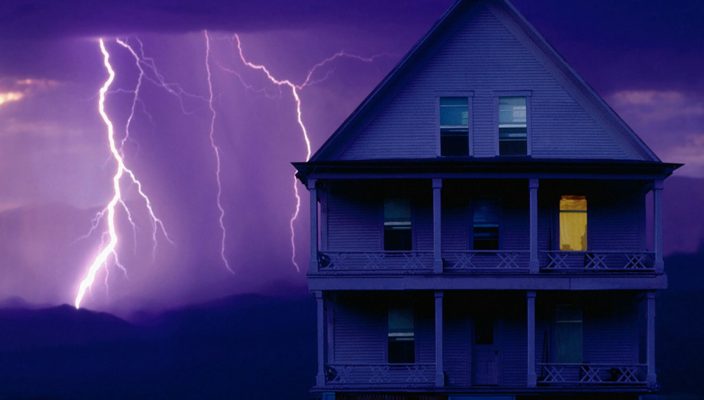

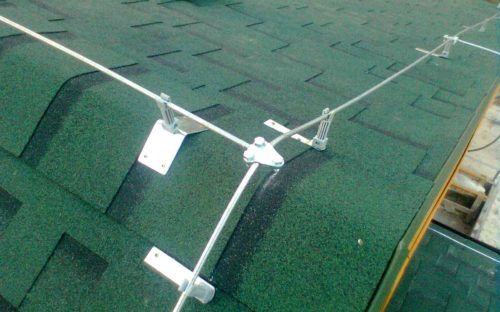
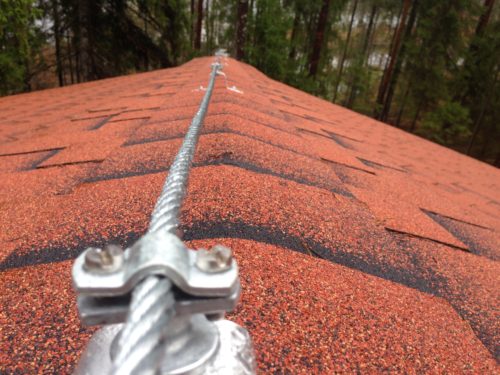
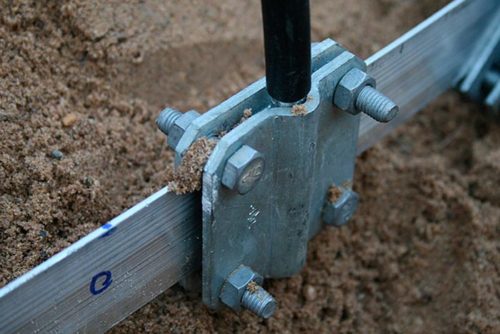
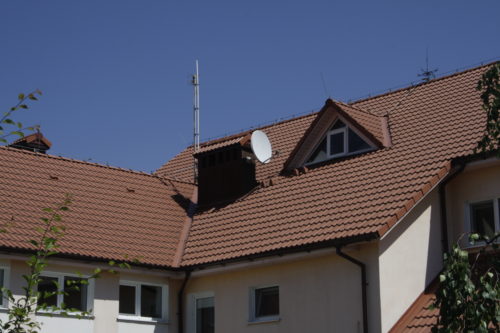
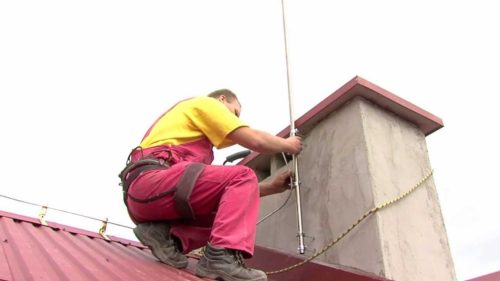


















I want to recommend a good company that is engaged in the provision of lightning protection. Our company did not understand the "steel-pro" when the need arose to provide lightning protection of industrial facilities http://www.steel-pro.ru/services/molniezashchita/molniezashchita-promyshlennykh-obektov/ . The company has established itself as a responsible partner who appreciates its reputation. Terms are always normal, shipping fast, prices - below average in the market. We are satisfied and recommend it to all